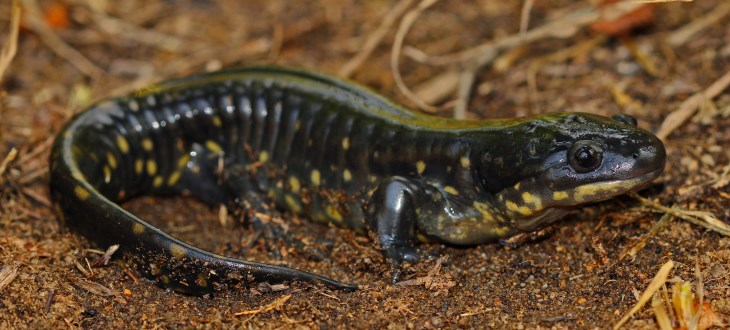The State We're In
What’s happening in nature during winter’s chill?
By Alison Mitchell, Co-Executive Director
New Jersey was quite frigid in December, but temperatures warmed as the new year arrived. So what’s happening in our forests and streams between these cold nights and mild days?
Endangered tiger salamanders might be breeding while you read this! These large amphibians are in a group called mole salamanders, which spend very little of their lives above ground. On a warm rainy night in early winter, when the air temperature is above 40 degrees, they migrate within southern New Jersey forests from uplands to fish-free vernal ponds.
Sometimes tiger salamanders can be seen beneath a few inches of ice, engaged in breeding activity. Imagine breeding while submerged in 35-degree water beneath the ice! You might say the salamanders approach the vernal ponds hoping to meet somebody “really cool.”
While the salamanders are heading to the breeding ponds, wingless female winter moths are climbing tree trunks. They don’t look like typical moths; rather they resemble tiny, gray, fat bags of eggs. Once they have climbed from the forest floor to about 6-12 feet high on a tree trunk, they emit their breeding perfumes, known as pheromones.
Tiny grayish-white males detect them as they are flying, patrolling the woodland. They can’t see much in the dark, but with their antennae they can pick up the scent of the females wafting in the gentle night air, down to a few parts per million. Camouflaged eggs are laid right on the bark in flat hexagonal clusters, and may hatch in the early spring, if they don’t get eaten by birds like nuthatches and brown creepers.
If a warm rainy night in January is bracketed by a couple of unusually warm days in the 60s, brumating (the reptile form of hibernating) snakes – including endangered timber rattlesnakes and corn snakes – emerge from their winter dens to warm their bodies temporarily. Sometimes reptiles enter their dens in the autumn with skin abrasions. Warming up on a mild winter day, if the opportunity presents itself, helps them fight off bacterial or fungal infections.
A few years ago, a naturalist was exploring a Pine Barrens swamp on a 71-degree January day, and he found himself standing in the middle of a dozen, highly camouflaged timber rattlesnakes that had popped above the surface to catch a few rays. Fortunately, the venomous snakes were too chilly to be aggravated by the interloper!
Adult mourning cloak butterflies, box turtles, and many other upland species have natural antifreeze in their veins and soft tissue. Mourning cloaks spend the winter at or near the ground surface in the uplands or in hollows in trees, and box turtles hunkered-down in depressions in the ground. Even though their entire bodies go well below freezing for extended time periods during the depths of winter, their tissues remain unharmed and they emerge early in spring, ready to mate.
The first woody plant to flower in New Jersey is the mat-forming broom crowberry on sand dunes in the heart of the Pine Barrens. Unlike most plants, which have both male and female parts, broom crowberries are like holly trees in that each individual is either only male or female.
Flowering can occur as early as mid-February, if a couple of mild days and nights occur in sequence. If your feet brush against a flowering broom crowberry male while hiking, loads of yellow pollen will rise from inconspicuous flowers. If no pollen clouds appear, the plant is likely a female covered with miniscule purple styles, ready for a pollen grain from a neighboring male to land on its sticky stigmatic surface.
All around New Jersey in January and February, bald eagles are laying their eggs in their VW Beetle-sized nests built in sturdy crotches within strong trees. In addition to feeding on fish, bald eagles prey on geese, gulls, roadkill, and small mammals that are easy pickings because they’re also out looking for food to fuel their demanding warm-blooded metabolisms.
This winter, get outside and enjoy watching for winter wildlife!
A few days after a snowstorm but before it melts, go hiking through the woods a little off-trail, and try to identify the dizzying array of mammal tracks that crisscross the forest floor. You’ll gain a keen insight into the plight of various herbivores and carnivores that scour the forest in search of essential food items during winter.
Another fun winter activity is viewing the vast array of visiting waterfowl that come to New Jersey’s coast from the prairie provinces of Canada and the upper Midwest of the U.S. during winter. Check out coastal lakes, bays, river inlets, and ocean beaches to watch close-up the courtship behavior of over a dozen species of beautiful ducks, including hooded mergansers, buffleheads, American wigeons and ring-necked ducks. Winter waterfowl can also be seen at inland reservoirs like Round Valley, Whitesbog, Spruce Run and Merrill Creek, as long as they’re not frozen over.
Almost all the female ducks choose their males for the year before they leave their wintering grounds and return to their prairie potholes over 1,000 miles away!
To find out where wintering birds are being spotted in New Jersey, go to the eBird website at https://ebird.org/region/US-NJ.
And to learn about preserving New Jersey’s land and natural resources, visit the New Jersey Conservation Foundation website at www.njconservation.org or contact me at info@njconservation.org.
About the Authors
Alison Mitchell
Co-Executive Director
John S. Watson, Jr.
Co-Executive Director
Tom Gilbert
Co-Executive Director, 2022-2023
Michele S. Byers
Executive Director, 1999-2021
View their full bios here.
Filter
Get The Latest News
From The Garden State
In the
News

